Search Result
| Isoforms Recommended: |
ERα
|
Results for "
ERα
" in MedChemExpress (MCE) Product Catalog:
1
Isotope-Labeled Compounds
| Cat. No. |
Product Name |
Target |
Research Areas |
Chemical Structure |
-
- HY-132194
-
|
|
Estrogen Receptor/ERR
|
Cancer
|
|
ERα degrader-2 is a selective estrogen receptor degrader (SERD) with potent binding affinity with ERα (IC50=17.1 nM), good degradation efficacy (EC50=0.3 nM). ERα degrader-2 exhibits favorable pharmacokinetic properties and excellent agentgability, can be used for HER + breast cancer research .
|
-
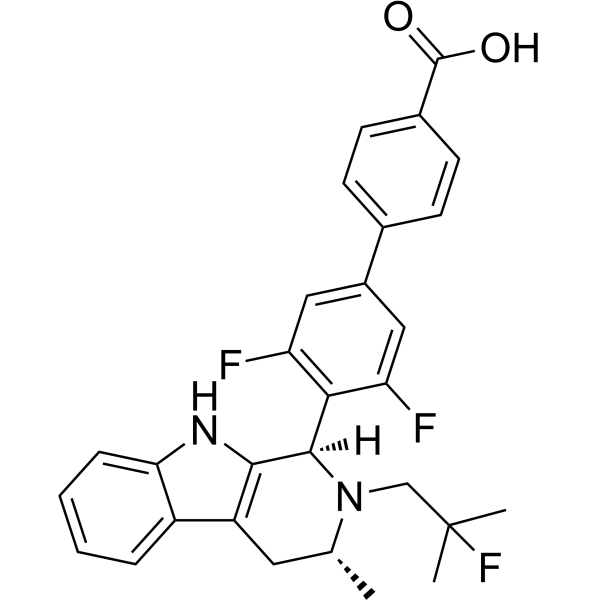
-
- HY-155492
-
|
|
Estrogen Receptor/ERR
|
Cancer
|
|
ERα degrader 7 (compound B1) is a potent ERα degrader with an IC50 of 14.6 nM and a DC50 of 9.7 nM, respectively. ERα degrader 7 shows excellent antitumor activity, indicating its potential to evolve as a promising selective estrogen-receptor degrader (SERD) for breast cancer research .
|
-

-
- HY-144306
-
|
|
Estrogen Receptor/ERR
Apoptosis
|
Cancer
|
|
ERα degrader 4 is an excellent and selective estrogen receptor α (ERα) degrader (IC50 of 0.31, 0.41 and 0.48 μM in MDA-MB-231, MCF-7 and MCF-7/ADR cells, respectively). ERα degrader 4 has potent inhibitory activity against MCF-7 cell lines. ERα degrader 4 is a potential SERDs candidate for the research of breast cancer .
|
-
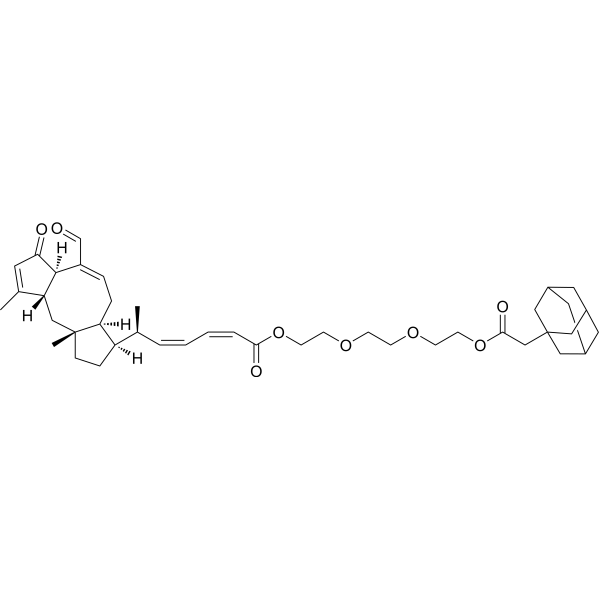
-
- HY-146267
-
|
|
Estrogen Receptor/ERR
|
Cancer
|
|
ERα degrader 5 (Compound 40) is a selective, orally bioavailable estrogen receptor (ER) degrader (SERD) with an EC50 of 1.1 nM against ERα. ERα degrader 5 shows antitumor effect in vivo .
|
-
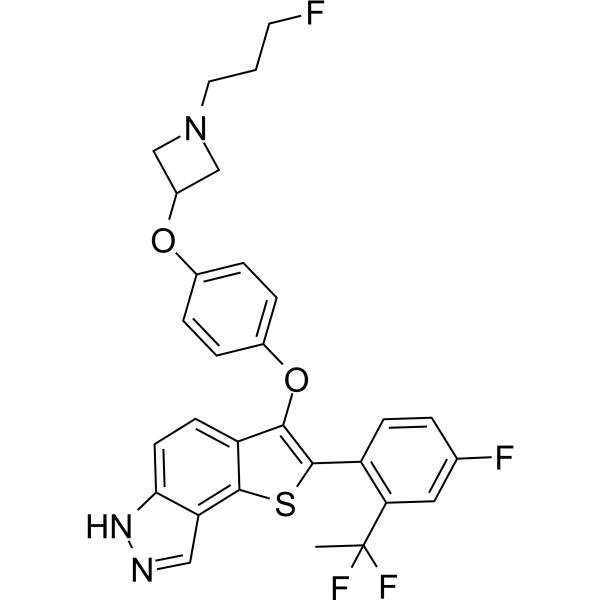
-
- HY-144733
-
|
|
Estrogen Receptor/ERR
Apoptosis
|
Cancer
|
|
ERα antagonist 1 (Compound 19d) is a potent, selective, covalent estrogen receptor α (ERα) antagonist. ERα antagonist 1 induces apoptosis and cell cycle G0/G1 phase arrest in MCF-7 cells .
|
-
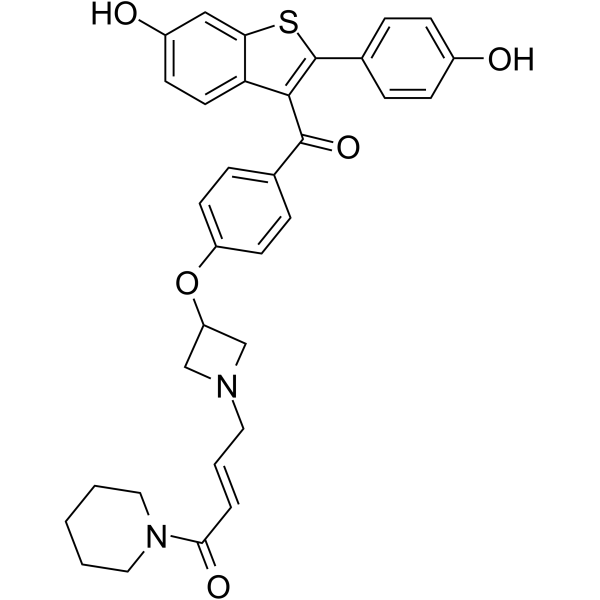
-
- HY-149081
-
|
|
Estrogen Receptor/ERR
Cytochrome P450
|
Cancer
|
|
ERα degrader 6 (Compound 31q) is an ERα degrader (KI: 75 nM). ERα degrader 6 also inhibits ARO with an IC50 of 37.7 nM. ERα degrader 6 inhibits tumor growth in MCF-7 tumor xenograft model. ERα degrader 6 can be used for breast cancer research .
|
-

-
- HY-111845
-
-
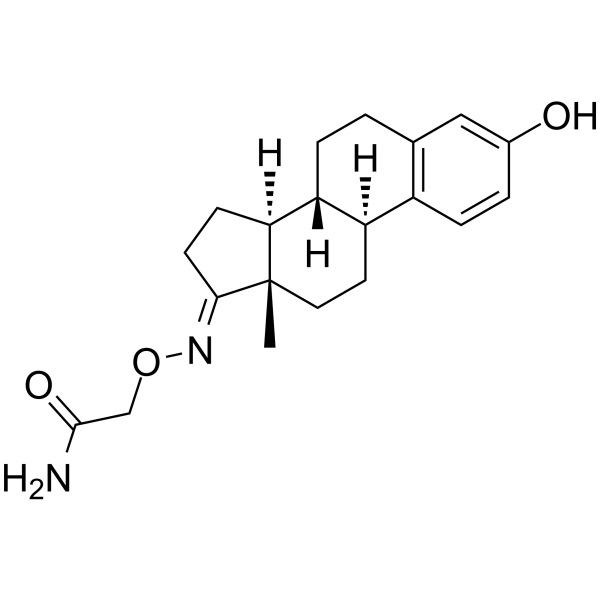
-
- HY-156125
-
|
|
Estrogen Receptor/ERR
|
Others
|
|
14-3-3σ/ERα stabilizer-1 (Compound 181) is a covalent 14-3-3σ/ERα stabilizer. 14-3-3σ/ERα stabilizer-1 can be used for research of molecular glues .
|
-

-
- HY-149295
-
|
|
PROTACs
Estrogen Receptor/ERR
Apoptosis
|
Cancer
|
|
PROTAC ERα Degrader-4 is a highly potent and selectivePROTAC ERα degrader (Ki: 5.08 μM). PROTAC ERα Degrader-4 contains OBHSAs, linker and E3 ligase ligands. PROTAC ERα Degrader-4 shows excellent cell inhibitory and ERα degradation activity against Tamoxifen-sensitive and -resistant ER + breast cancer (BC) cells and ERα-mutated BC cells. PROTAC ERα Degrader-4 can induce apoptosis and can be used for cancer research.
|
-

-
- HY-145556
-
|
|
Estrogen Receptor/ERR
|
Cancer
|
|
Bexirestrant is an orally active ER-α degrader. Bexirestrant can be used for the research of antiestrogen, antineoplastic .
|
-

-
- HY-112098
-
|
|
PROTACs
Estrogen Receptor/ERR
|
Cancer
|
|
PROTAC ERα Degrader-1 comprises an ubiquitin E3 ligase binding group, a linker and a protein binding group. PROTAC ERα Degrader-1 extracts from patent WO2017201449A1, compound P1. PROTAC ERα Degrader-1 is an estrogen receptor-alpha (ERα) degrader.
|
-
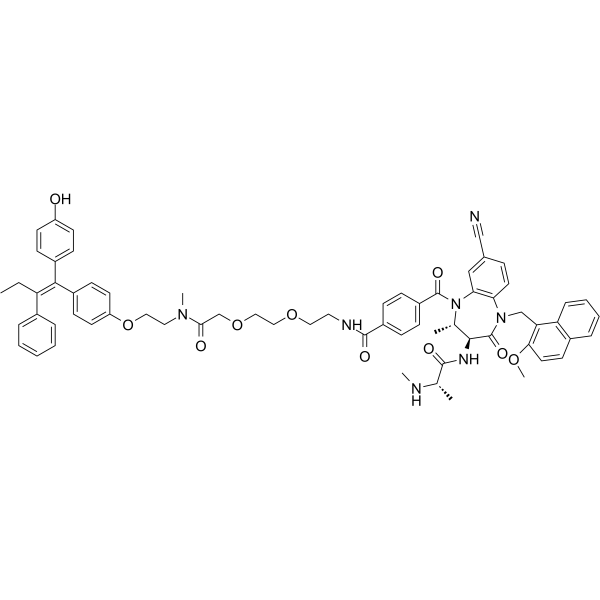
-
- HY-112100
-
|
|
PROTAC-Linker Conjugates for PAC
Estrogen Receptor/ERR
|
Cancer
|
|
PROTAC ERα Degrader-5 (compound LP2) consists an ADC linker and a PROTAC, whcih can be conjugated to an antibody to form PACs. PROTAC ERα Degrader-5 conjugated to an antibody is a more marked estrogen receptor-alpha (ERα) degrader compared to PROTAC (without Ab) .
|
-
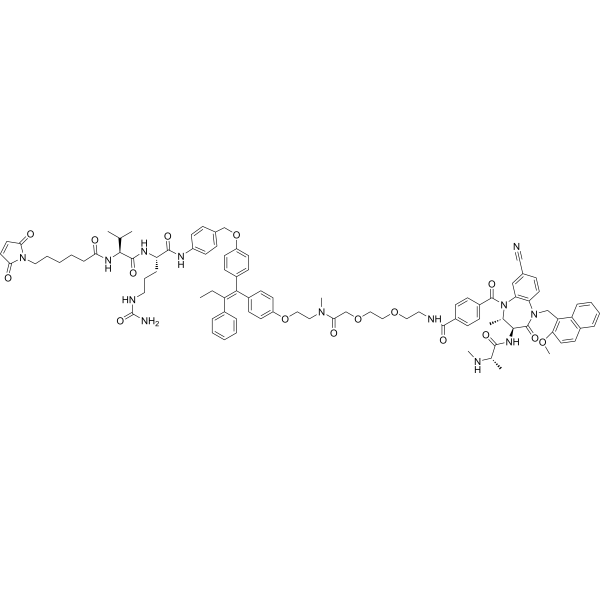
-
- HY-111846
-
|
|
SNIPERs
PROTACs
Estrogen Receptor/ERR
|
Cancer
|
|
PROTAC ERα Degrader-2 comprises a IAP ligand binding group, a linker and an estrogen receptor α (ERα) binding group. PROTAC ERα Degrader-2 is an ERα degrader. Maximal ERα degradation at 30 μM concentration in human mammary tumor MCF7 cells. Degradation inducers based on cIAP1 are called specific and non-genetic IAP-dependent protein erasers (SNIPERs) .
|
-
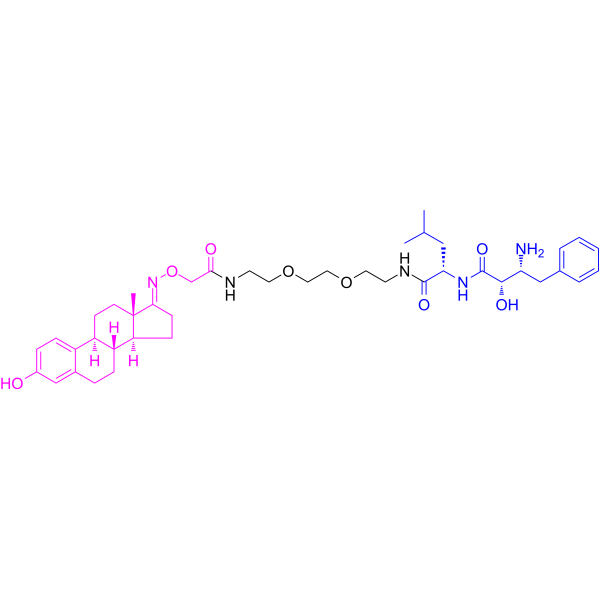
-
- HY-157765
-
|
|
PROTACs
Estrogen Receptor/ERR
|
Cancer
|
|
PROTAC ERα Degrader-6 (compound A3) is a potent PROTAC degrader of ERα, with DC50 of 0.12 μM. PROTAC ERα Degrader-6 has anti-tumor effect. PROTAC ERα Degrader-6 is a fluorescent probes with Em of 582 nm that enable real-time visualization of ERα protein degradation .
|
-
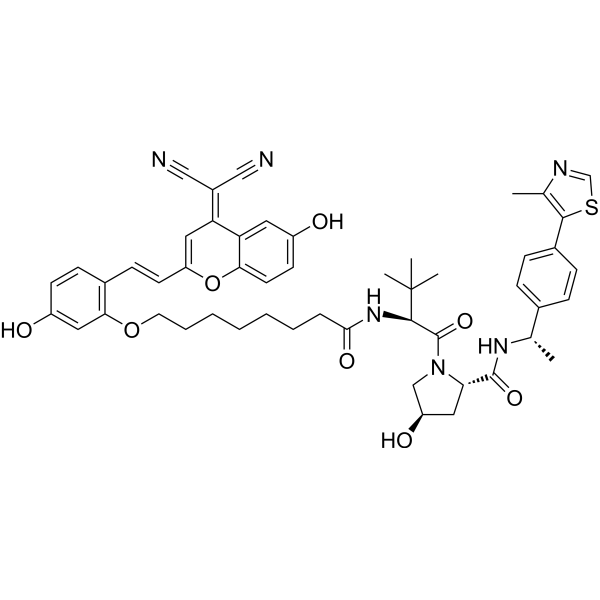
-
- HY-160562
-
|
|
PROTACs
Estrogen Receptor/ERR
|
Cancer
|
|
PROTAC ERα Degrader-7 (compound i-320) is a potent estrogen receptor alpha(ERα) PROTAC degrader with a DC50 value of 0.000006 µM. PROTAC ERα Degrader-7 comprises a cereblon-binding moiety LBM linked to a ligand ERBM that binds ERα and comprises a benzofused partially saturated 6-membered carbocyclic or heterocyclic ring .
|
-

-
- HY-160563
-
-
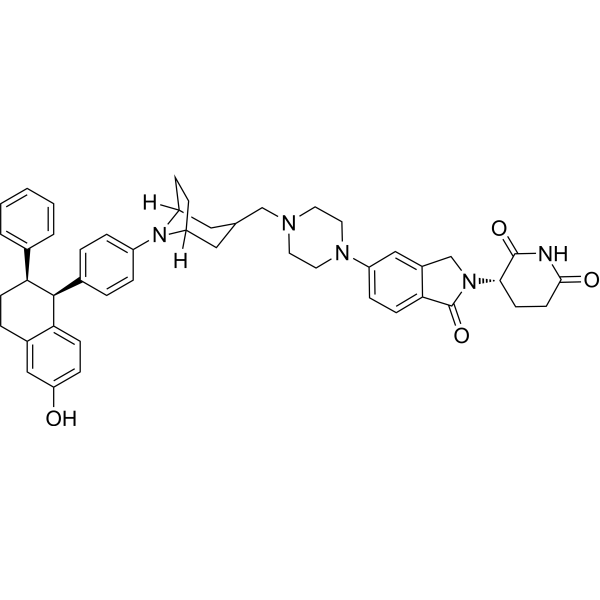
-
- HY-111484A
-
|
SRN-927 Racemate
|
Estrogen Receptor/ERR
|
Cancer
|
|
GDC-0927 Racemate (SRN-927 Racemate) is a degrader of estrogen receptor, potently inhibits ER-α activity, with an IC50 of 0.2 nM, and is used in the research of ER-related diseases.
|
-
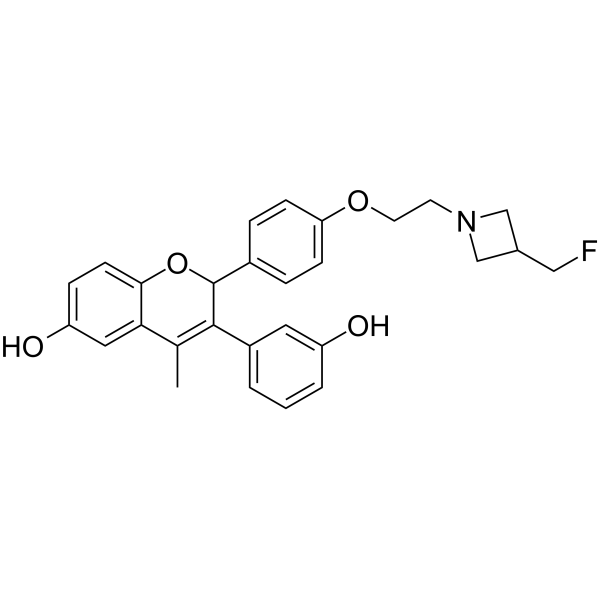
-
- HY-19498
-
|
SIM-688
|
|
|
|
WAY-204688 is an estrogen receptor (ER-α) selective, orally active inhibitor of NF-κB transcriptional activity with an IC50 of 122 ± 30 nM for NF-κB-luciferase (NF-κB-luc) in HAECT-1 cells.
|
-
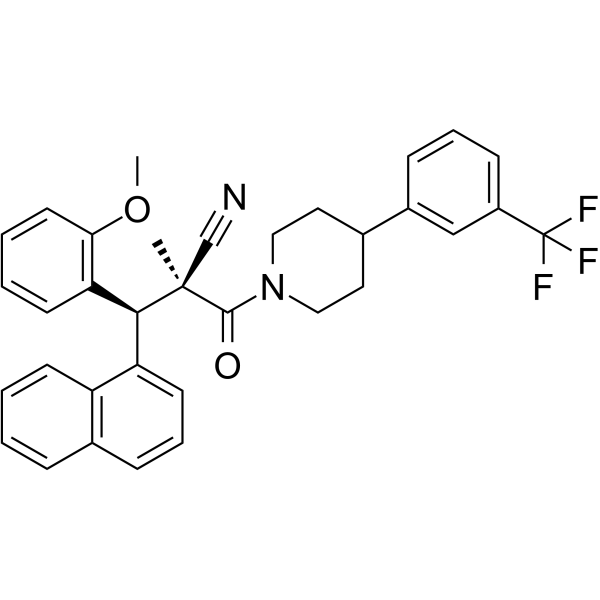
-
- HY-155196
-
|
|
Estrogen Receptor/ERR
|
Cancer
|
|
ER degrader 6 (compound 35s) is a potent Estrogen Receptor (ER)α degrader. ER degrader 6 disrupts the microtubule network by restraining tubulin polymerization. ER degrader 6 suppresses tumor growth without noticeable poisonousness .
|
-

-
- HY-145071
-
|
|
PROTACs
Estrogen Receptor/ERR
|
Cancer
|
|
PROTAC ERα Y537S degrader-1 comprises a ubiquitin E3 ligase binding group, a linker and a protein binding group. PROTAC ERα Y537S degrader-1 extracts from patent WO2021143822, example 12. PROTAC ERα Y537S degrader-1 is an estrogen receptor-alpha (ERα) Y537S degrader .
|
-
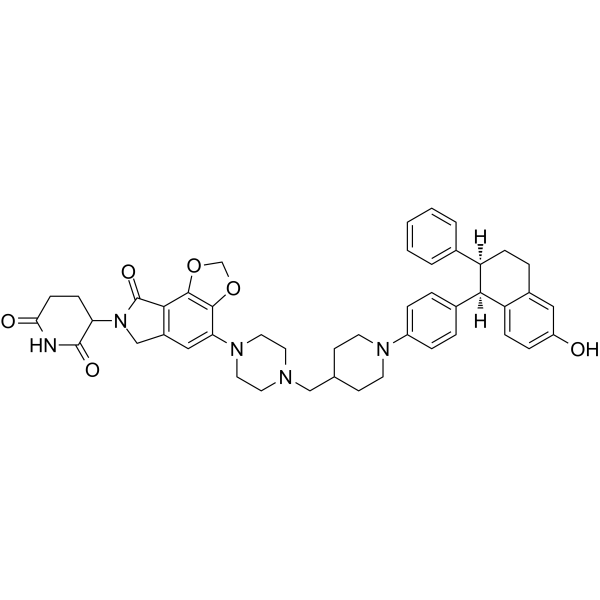
-
- HY-N7748A
-
-
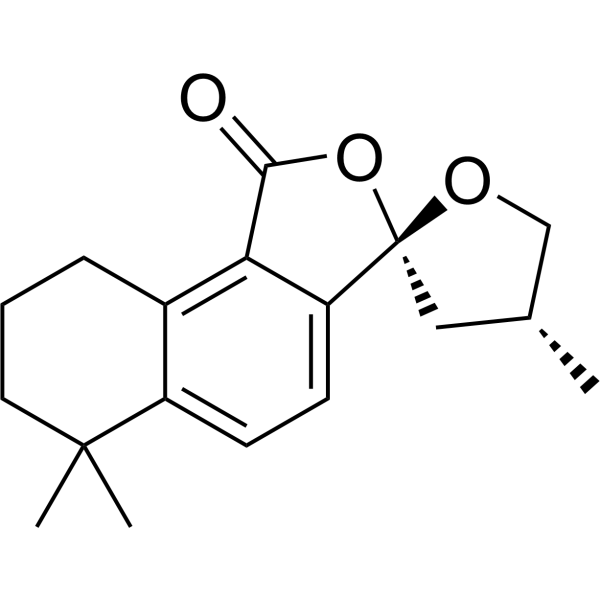
-
- HY-125263
-
|
|
Estrogen Receptor/ERR
|
Cancer
|
|
OP-1074 is a pure antiestrogen and a selective ER degrader (PA-SERD), shows specific antiestrogenic activity for ERα and ERβ, inhibits 17β-estradiol (E2)-stimulated transcriptional activity with IC50 of 1.6 and 3.2 nM, respectively .
|
-
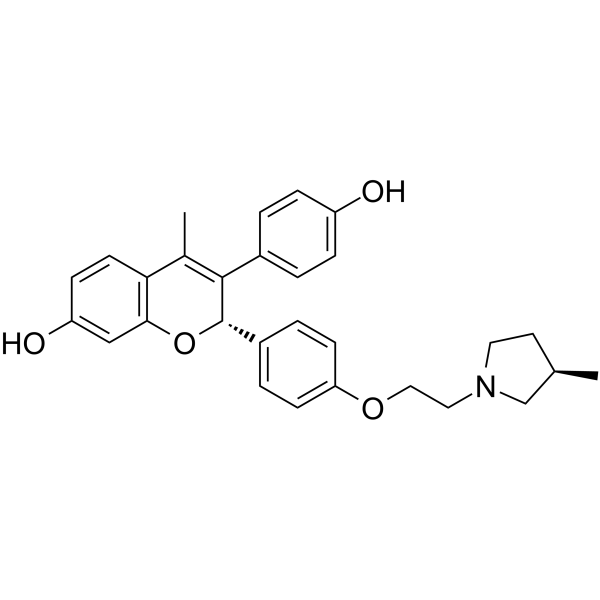
-
- HY-135590
-
|
|
Estrogen Receptor/ERR
|
|
|
Raloxifene 4-Monomethyl Ether (Compound 37) is a Raloxifene derivative that inhibits estrogen receptor α. Raloxifene 4-Monomethyl Ether inhibits MCF-7 cells with an IC50 of 1 μM and a pIC50 of 6 .
|
-
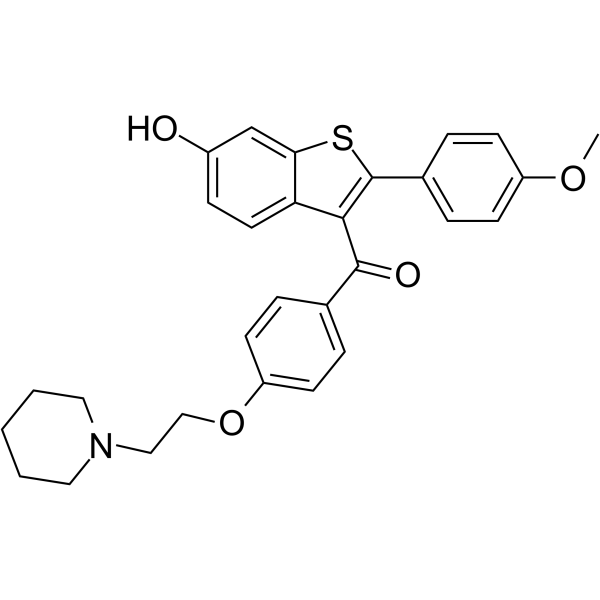
-
- HY-125263B
-
|
|
Others
|
Cancer
|
|
(R)-OP-1074 is the isomer of OP-1074 (HY-125263), and can be used as an experimental control. OP-1074 is a pure antiestrogen and a selective ER degrader (PA-SERD), shows specific antiestrogenic activity for ERα and ERβ, inhibits 17β-estradiol (E2)-stimulated transcriptional activity with IC50 of 1.6 and 3.2?nM, respectively .
|
-
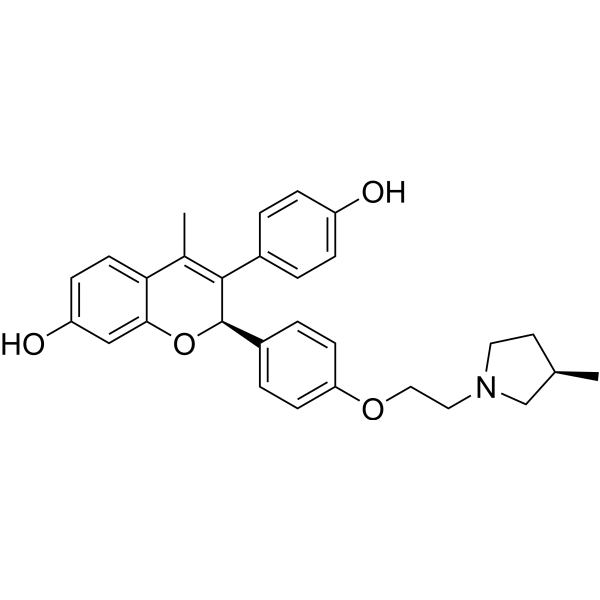
-
- HY-135584
-
|
|
Estrogen Receptor/ERR
|
|
|
Raloxifene 6-Monomethyl Ether (Compound 7) is a Raloxifene derivative that inhibits estrogen receptor α. Raloxifene 4-Monomethyl Ether inhibits MCF-7 cells with an IC50 of 250 nM and a pIC50 of 6.6 .
|
-
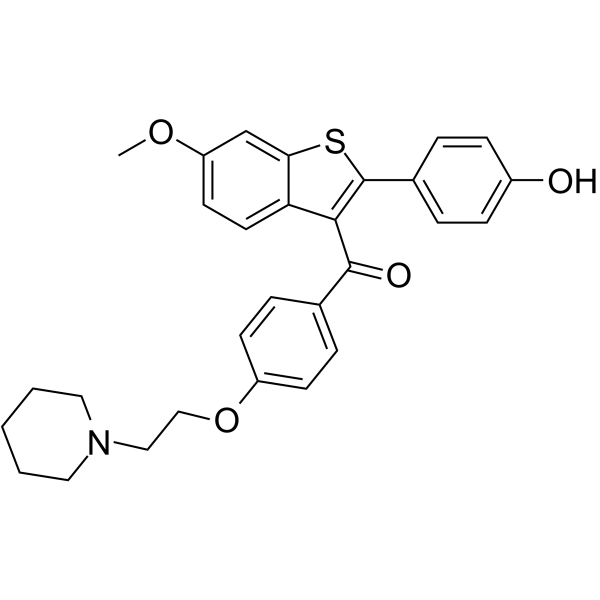
-
- HY-103454
-
|
|
Estrogen Receptor/ERR
Apoptosis
|
Endocrinology
Cancer
|
|
MPP dihydrochloride is a potent and selective ER (estrogen receptor) modulator. MPP dihydrochloride induces significant apoptosis in the endometrial cancer and oLE cell lines. MPP dihydrochloride reverses the positive effects of beta-estradiol. MPP dihydrochloride has mixed agonist/antagonist action on murine uterine ERalpha in vivo .
|
-
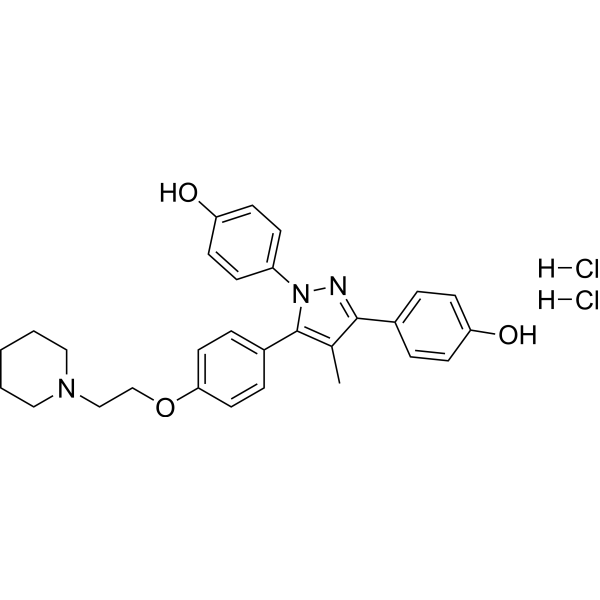
-
- HY-144137
-
|
|
Estrogen Receptor/ERR
|
Cancer
|
|
Estrogen receptor antagonist 1 is a selective estrogen receptor antagonist. Estrogen (E2) and estrogen alpha receptor (ERα) are important drivers of breast cancer development. Estrogen receptor antagonist 1 has the potential for the research of breast cancer diseases (extracted from patent WO2021249533A1, compound 4) .
|
-
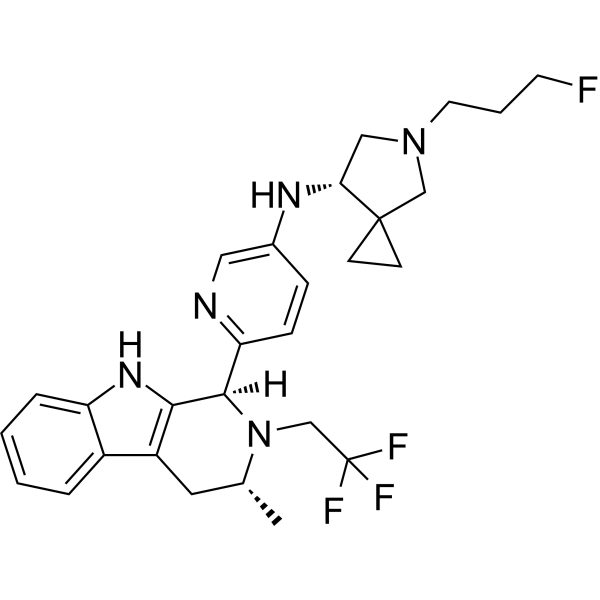
-
- HY-144138
-
|
|
Estrogen Receptor/ERR
|
Cancer
|
|
Estrogen receptor antagonist 2 is a selective estrogen receptor downregulator. Estrogen (E2) and estrogen alpha receptor (ERα) are important drivers of breast cancer development. Estrogen receptor antagonist 2 has the potential for the research of breast cancer diseases (extracted from patent WO2021228210A1, compound 3) .
|
-

-
- HY-144314
-
|
|
Estrogen Receptor/ERR
|
Cancer
|
|
PSDalpha is an ERα degrader conjugating photosensitizer (PS), triphenylamine benzothiadiazole (TB) and 17β-estradiol via an acetylene bond. PSDalpha shows excellent anti-proliferation performance on MCF-7 cells. The maximum absorption wavelength of PSDalpha in the visible region is located at 465 nm .
|
-

-
- HY-127133
-
|
MPP
|
Biochemical Assay Reagents
|
|
|
MPP is a highly selective estrogen receptor alpha (ERα) antagonist. MPP reduces the ratio of p-ERα/ERα .
https://www.ncbi.nlm.nih.gov/pubmed/29799481
Labouesse MA, et al. Effects of selective estrogen receptor alpha and beta modulators on prepulse inhibition in male mice. Psychopharmacology (Berl). 2015 Aug;232(16):2981-94.
https://www.ncbi.nlm.nih.gov/pubmed/25893642
|
-

-
- HY-103457
-
|
|
Estrogen Receptor/ERR
|
Cancer
|
|
Y134 is a selective and orally active oestrogen receptor (ER) modulator (SERM), exhibits potent antagonist activity at ERα and ERβ. Y134 shows 121.1-fold selectivity for ERα (Ki=0.09 nM) over ERβ (Ki=11.31 nM). Y134 inhibits oestrogen-stimulated proliferation of ER-positive human breast cancer cells .
|
-
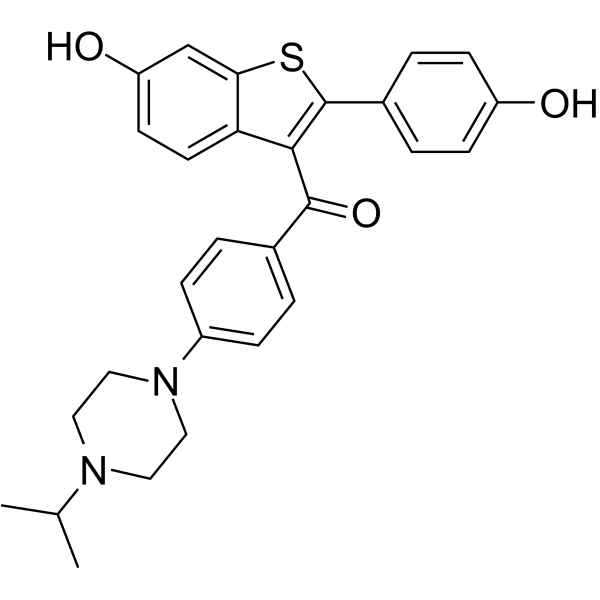
-
- HY-125703
-
|
|
Estrogen Receptor/ERR
Apoptosis
|
Infection
Inflammation/Immunology
Endocrinology
Cancer
|
|
Ferutinin, a natural terpenoid compound, is an estrogen receptor ERα agonist and estrogen ERβ-receptor agonist/antagonist with IC50s of 33.1 nM and 180.5 nM, respectively. Ferutinin acts as an electrogenic Ca 2+-ionophore that increases calcium permeability of lipid bilayer membranes, mitochondria. Ferutinin possesses estrogenic, antitumor, antibacterial and antiinflammatory activities .
|
-
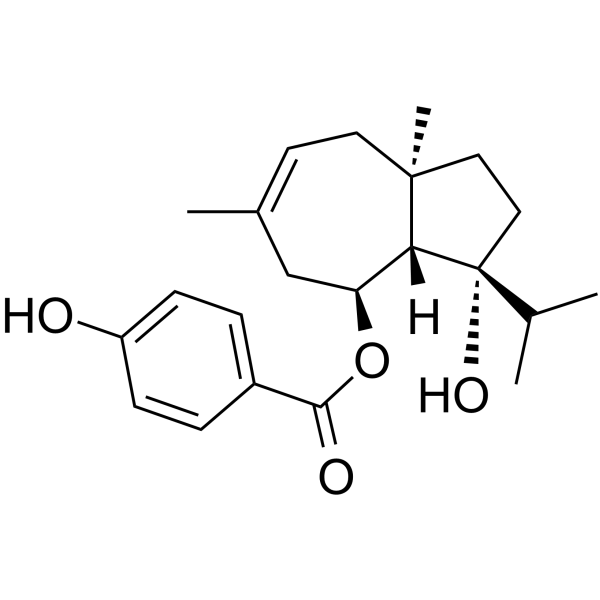
-
- HY-150505
-
|
|
Deubiquitinase
Apoptosis
|
Cancer
|
|
DC-U4106 is a USP8 targeting inhibitor with the Kdvalue of 4.7 μM and the IC50 value of 1.2 μM. DC-U4106 can target the ubiquitin pathway and facilitate the degradation of Erα. DC-U4106 inhibits tumor growth with minimal toxicity and has the potential for the research of breast cancer .
|
-
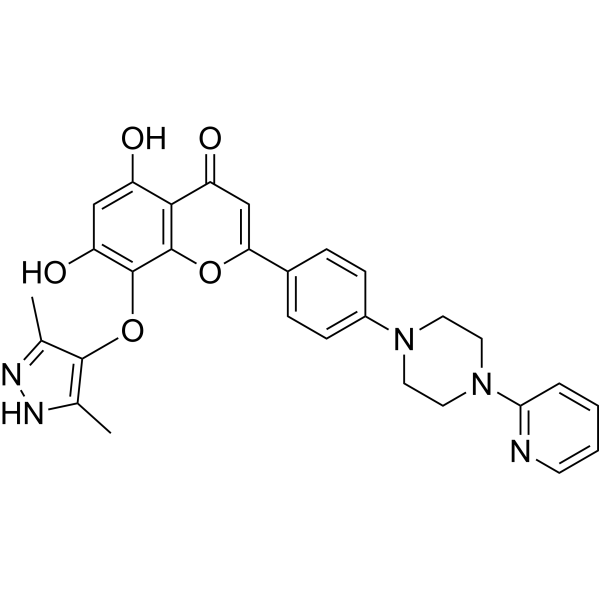
-
- HY-144070A
-
|
|
Estrogen Receptor/ERR
|
Cancer
|
|
(Rac)-ErSO-DFP is a derivative of ErSO-DFP and a selective small molecule Erα biomodulator. (Rac)-ErSO-DFP againsts ERα+ breast cancer (including resistant tumors) by hyperactiving the Erα-dependent a-UPR (extracted from patent WO2022087234A1) .
|
-
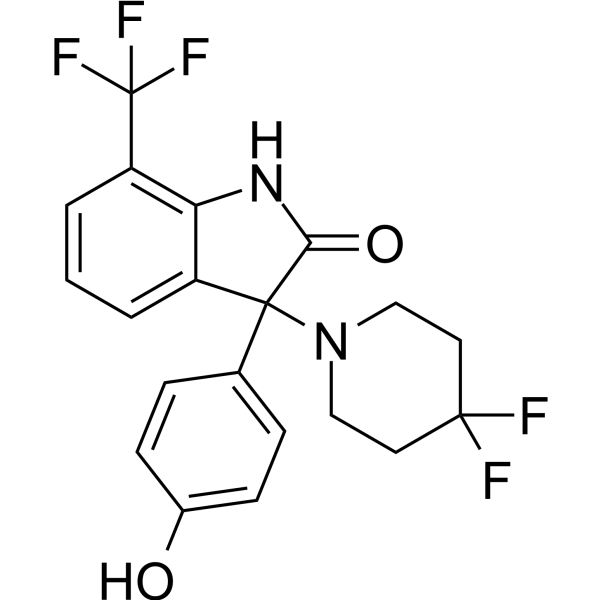
-
- HY-16023A
-
|
EM-652; SCH 57068
|
Estrogen Receptor/ERR
|
Cancer
|
|
Acolbifene (EM-652), the active metabolite of EM800, is an orally active pure antiestrogen and selective estrogen receptor antagonist. Acolbifene (EM-652) inhibits estradiol (E2)-induced transcriptional activity of ERα (IC50 = 2 nM) and ERβ (IC50 = 0.4 nM). Acolbifene (EM-652) possesses potent and pure anticarcinogenic properties .
|
-
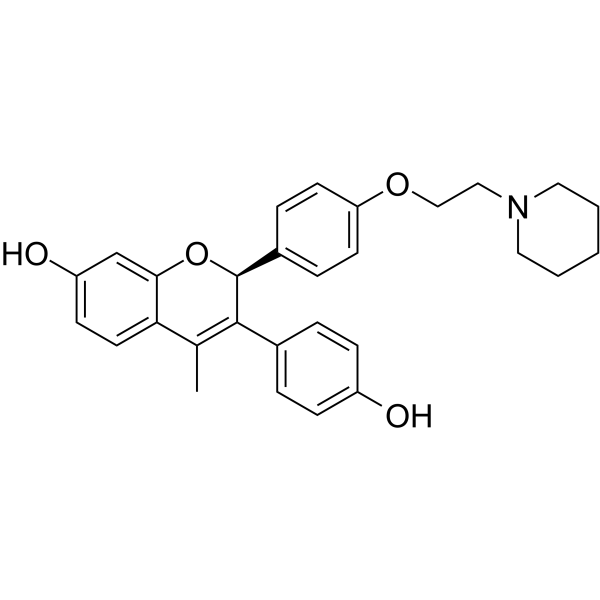
-
- HY-B0723S
-
|
FC-1271a d4
|
Estrogen Receptor/ERR
|
Cancer
|
|
Ospemifene-d4 is a deuterium labeled Ospemifene. Ospemifene is a selective and orally active estrogen receptor modulator for the prevention of osteoporosis with IC50 values of 827 nM and 1633 nM for estrogen receptor α (ERα) and ERβ, respectively. Ospemifene has bone-sparing, antitumor, and cholesterol-lowering effects[1][2].
|
-
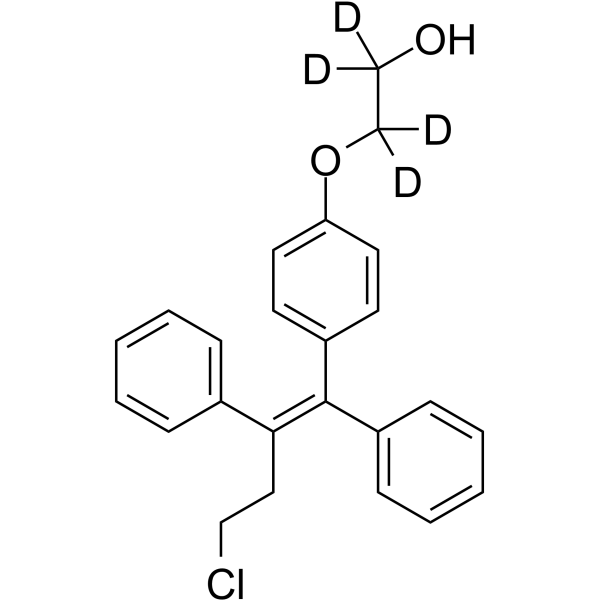
-
- HY-16023
-
|
EM-652 hydrochloride; SCH 57068 hydrochloride
|
Estrogen Receptor/ERR
|
Cancer
|
|
Acolbifene (EM-652) hydrochloride, an active metabolite of EM800, is an orally active, cancer-preventing selective estrogen receptor modulator (SERM). Acolbifene (EM-652) hydrochloride inhibits estradiol (E2)-induced transcriptional activity of ERα (IC50=2 nM) and ERβ (IC50=0.4 nM). Acolbifene (EM-652) hydrochloride exerts a potent and pure antiestrogenic action in the mammary gland and uterus. Anticarcinogenic properties .
|
-
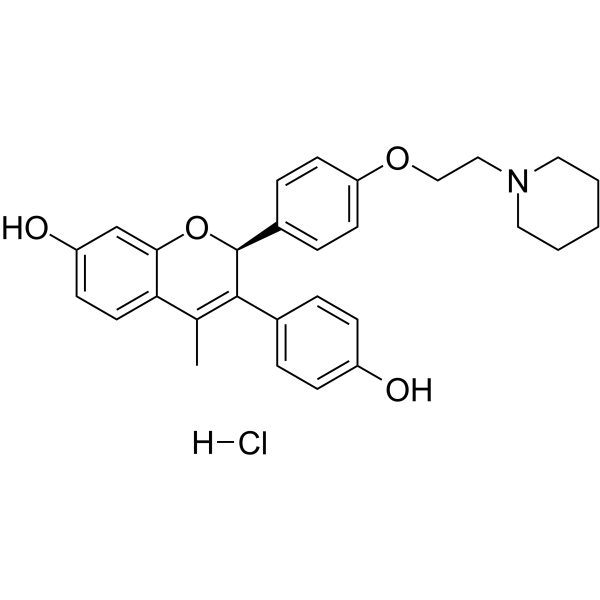
-
- HY-162312
-
|
|
Deubiquitinase
Apoptosis
|
Cancer
|
|
LLK203 is a potent USP2/USP8 dual-target inhibitor with IC50s of 0.89 μM and 0.52 μM, respectively. LLK203 leads a degradation of ERα and induces apoptosis of breast cancer MCF-7 cells. LLK203 demonstrates antitumor activities against the 4T1 tumor mice model .
|
-
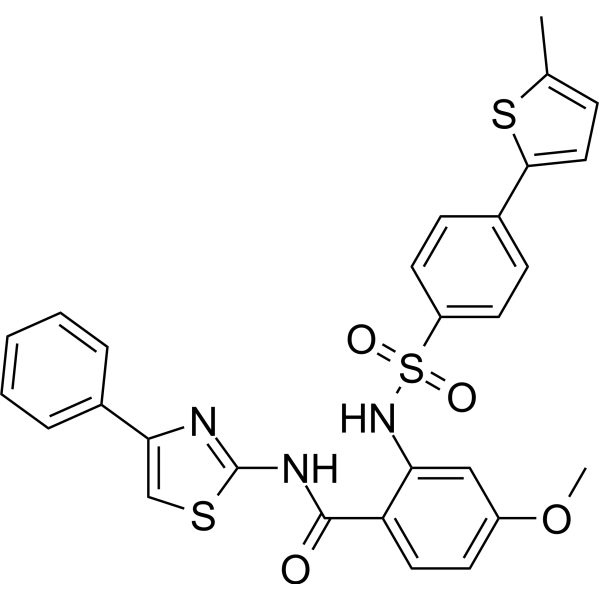
-
- HY-145341
-
|
|
Estrogen Receptor/ERR
|
Cancer
|
|
GNE-149 is an orally bioavailable full antagonist of estrogen receptor α (ERα; IC50=0.053 nM). GNE-149 is a selective estrogen receptor degrader (SERD). GNE-149 can be used for the research of breast cancer .
|
-
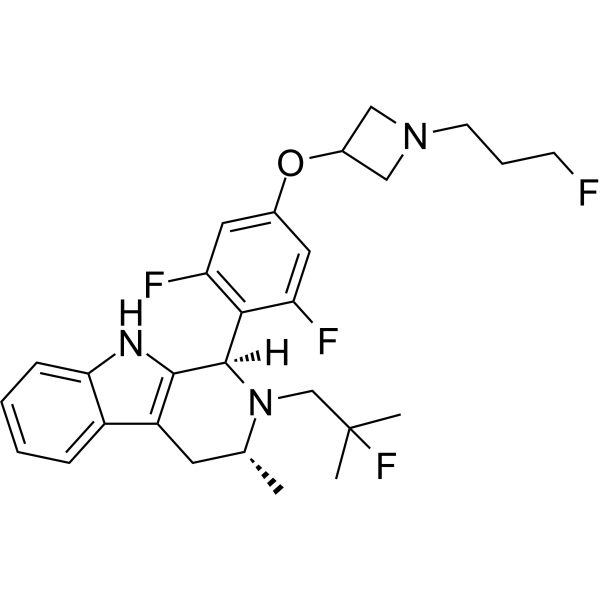
-
- HY-B0412
-
Estriol
3 Publications Verification
Oestriol
|
Estrogen Receptor/ERR
Endogenous Metabolite
|
Cancer
|
|
Estriol (Oestriol), an orally active estrogen, is a ERα and ERβ agonist. Estriol is a potent GPR30 antagonist in estrogen receptor-negative breast cancer cells. Estriol can ameliorate disease severity through immunomodulatory mechanisms that decrease tissue inflammation. Estriol has powerful proconvulsant effects .
|
-
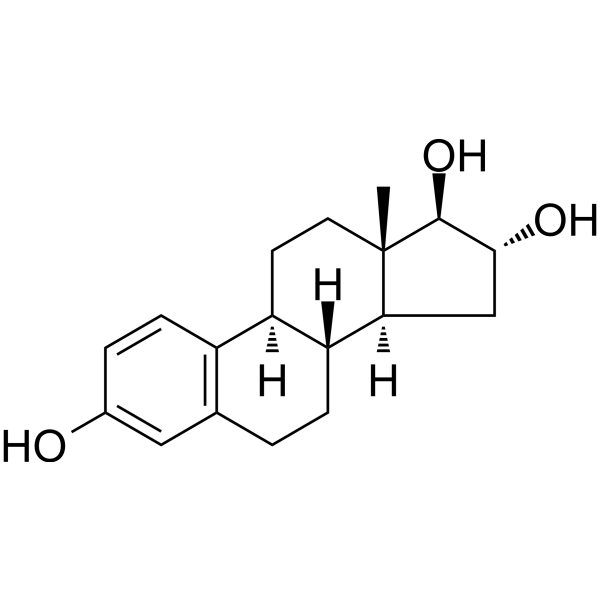
-
- HY-126109
-
|
|
Estrogen Receptor/ERR
Apoptosis
|
Metabolic Disease
Endocrinology
Cancer
|
|
(±)-8-Prenylnaringenin, a natural prenylated flavonoid, is a potent phytoestrogen. (±)-8-Prenylnaringenin is an orally active selective estrogen receptor modulator (SERM) (Estrogen Receptor/ERR) that inhibits ERα and ERβ with IC50s of 57 nM and 68 nM, respectively. (±)-8-Prenylnaringenin has anticancer effects, and can be used for osteoporosis research .
|
-

-
- HY-147165
-
|
|
YAP
|
Cancer
|
|
VT02956 is a LATS inhibitor (IC50: 0.76 nM for LATS1, 0.52 nM for LATS2). VT02956 targets the Hippo pathway. VT02956 inhibits ESR1 expression and growth of ER+ breast cancer cell lines and patient-derived tumor organoids . VT02956 is a click chemistry reagent, it contains an Alkyne group and can undergo copper-catalyzed azide-alkyne cycloaddition (CuAAc) with molecules containing Azide groups.
|
-
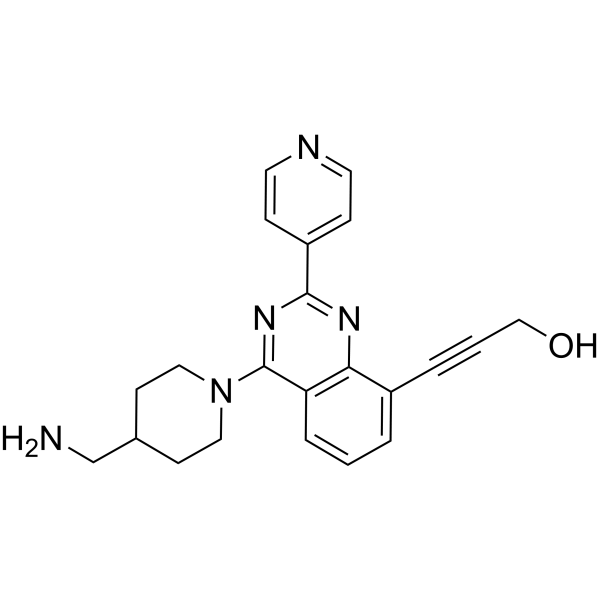
-
- HY-A0031
-
Bazedoxifene
Maximum Cited Publications
10 Publications Verification
TSE-424
|
Estrogen Receptor/ERR
|
Cancer
|
|
Bazedoxifene (TSE-424) is an oral, BBB-penetrant nonsteroidal selective estrogen receptor modulator (SERM), with IC50s of 23 nM and 99 nM for ERα and ERβ, respectively. Bazedoxifene can be used for the research of osteoporosis. Bazedoxifene also acts as an inhibitor of IL-6/GP130 protein-protein interactions and can be used for the research of pancreatic cancer .
|
-
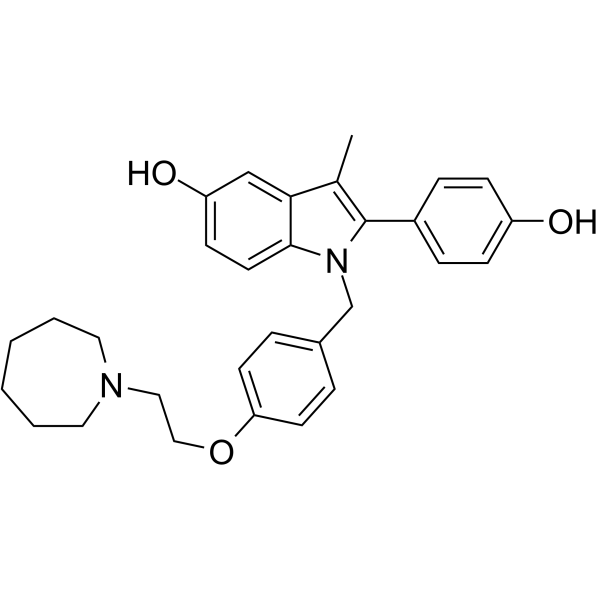
-
- HY-A0036
-
|
TSE-424 acetate
|
Estrogen Receptor/ERR
|
Cancer
|
|
Bazedoxifene acetate (TSE-424 acetate) is an oral, nonsteroidal selective estrogen receptor modulator (SERM), with IC50s of 23 nM and 99 nM for ERα and ERβ, respectively. Bazedoxifene acetate can be used for the research of osteoporosis. Bazedoxifene acetate also acts as an inhibitor of IL-6/GP130 protein-protein interactions and can be used for the research of pancreatic cancer .
|
-
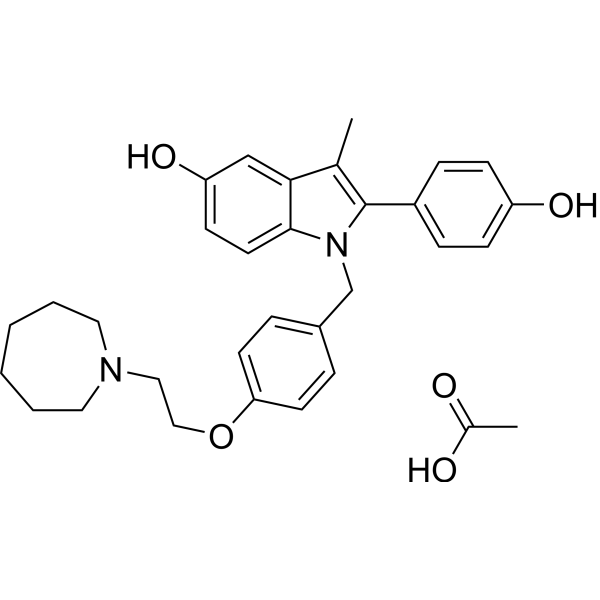
-
- HY-A0031A
-
|
TSE-424 hydrochloride
|
Estrogen Receptor/ERR
|
Cancer
|
|
Bazedoxifene hydrochloride (TSE-424 hydrochloride) is an oral active, BBB-penetrant nonsteroidal selective estrogen receptor modulator (SERM), with IC50s of 23 nM and 99 nM for ERα and ERβ, respectively. Bazedoxifene hydrochloride can be used for the research of osteoporosis. Bazedoxifene hydrochloride acts as an inhibitor of IL-6/GP130 protein-protein interactions. Bazedoxifene hydrochloride can be used for the research of pancreatic cancer .
|
-
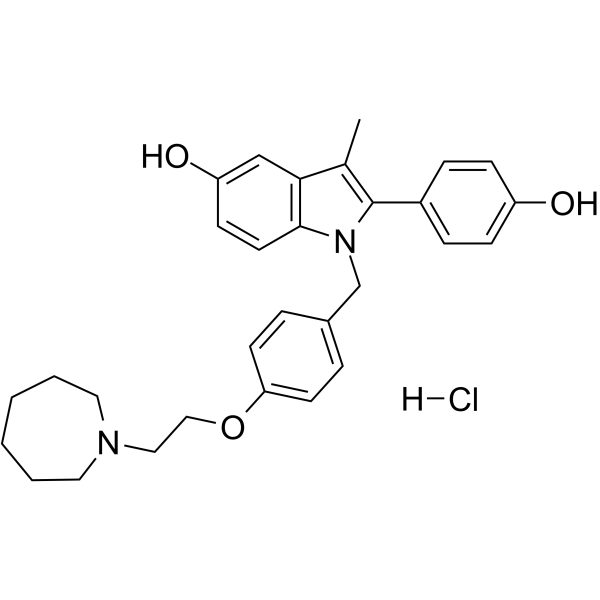
-
- HY-139999
-
|
|
Ligands for E3 Ligase
|
Cancer
|
|
LCL-PEG3-N3 is a decoy oligonucleotide ligand for E3 ligase which can be used for developing chimeric molecules LCL-ER(dec), degrading the estrogen receptor . LCL-PEG3-N3 is a click chemistry reagent, it contains an Azide group and can undergo copper-catalyzed azide-alkyne cycloaddition reaction (CuAAc) with molecules containing Alkyne groups. Strain-promoted alkyne-azide cycloaddition (SPAAC) can also occur with molecules containing DBCO or BCN groups.
|
-
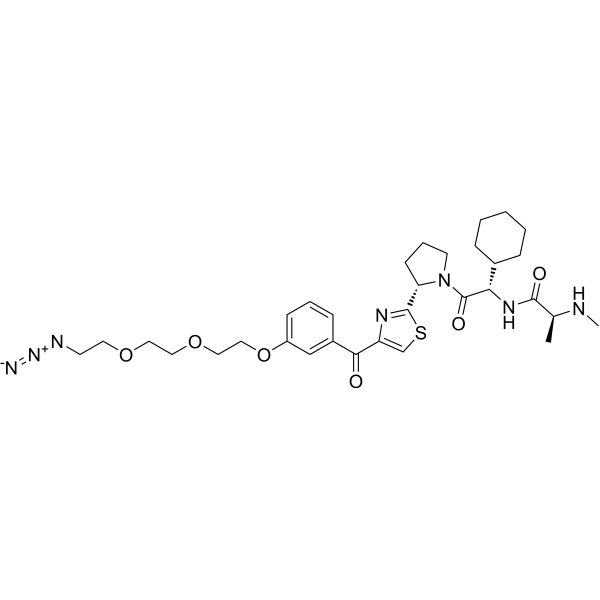
-
- HY-139999A
-
|
|
Ligands for E3 Ligase
|
Cancer
|
|
LCL-PEG3-N3 (hydrochloride) is a decoy oligonucleotide ligand for E3 ligase which can be used for developing chimeric molecules LCL-ER(dec), degrading the estrogen receptor . LCL-PEG3-N3 (hydrochloride) is a click chemistry reagent, it contains an Azide group and can undergo copper-catalyzed azide-alkyne cycloaddition reaction (CuAAc) with molecules containing Alkyne groups. Strain-promoted alkyne-azide cycloaddition (SPAAC) can also occur with molecules containing DBCO or BCN groups.
|
-
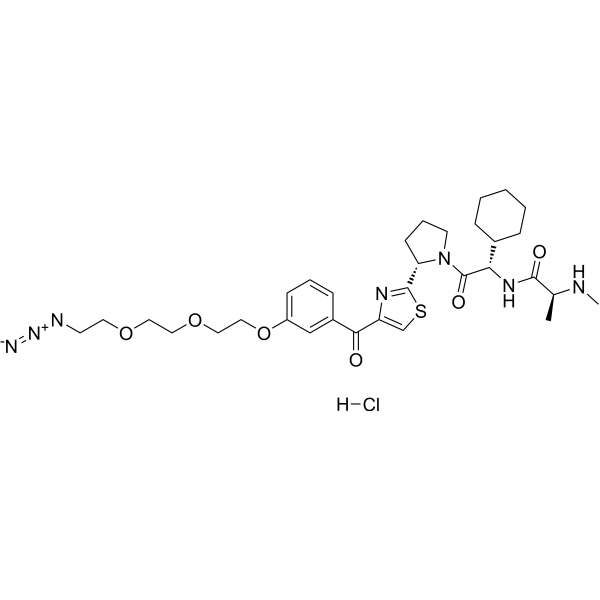
| Cat. No. |
Product Name |
Category |
Target |
Chemical Structure |
| Cat. No. |
Product Name |
Chemical Structure |
-
- HY-B0723S
-
|
|
|
Ospemifene-d4 is a deuterium labeled Ospemifene. Ospemifene is a selective and orally active estrogen receptor modulator for the prevention of osteoporosis with IC50 values of 827 nM and 1633 nM for estrogen receptor α (ERα) and ERβ, respectively. Ospemifene has bone-sparing, antitumor, and cholesterol-lowering effects[1][2].
|
-

| Cat. No. |
Product Name |
|
Classification |
-
- HY-139999
-
|
|
|
Azide
|
|
LCL-PEG3-N3 is a decoy oligonucleotide ligand for E3 ligase which can be used for developing chimeric molecules LCL-ER(dec), degrading the estrogen receptor . LCL-PEG3-N3 is a click chemistry reagent, it contains an Azide group and can undergo copper-catalyzed azide-alkyne cycloaddition reaction (CuAAc) with molecules containing Alkyne groups. Strain-promoted alkyne-azide cycloaddition (SPAAC) can also occur with molecules containing DBCO or BCN groups.
|
-
- HY-139999A
-
|
|
|
Azide
|
|
LCL-PEG3-N3 (hydrochloride) is a decoy oligonucleotide ligand for E3 ligase which can be used for developing chimeric molecules LCL-ER(dec), degrading the estrogen receptor . LCL-PEG3-N3 (hydrochloride) is a click chemistry reagent, it contains an Azide group and can undergo copper-catalyzed azide-alkyne cycloaddition reaction (CuAAc) with molecules containing Alkyne groups. Strain-promoted alkyne-azide cycloaddition (SPAAC) can also occur with molecules containing DBCO or BCN groups.
|
Your information is safe with us. * Required Fields.
Inquiry Information
- Product Name:
- Cat. No.:
- Quantity:
- MCE Japan Authorized Agent:























































